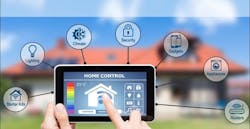How European Technology Can Benefit U.S. Builders
The U.S. home building industry is experiencing a dramatic renaissance of innovation, resulting from concurrent revolutions in digital data capture and green building practices that have accelerated with the COVID-19 pandemic to more widespread adoption of new technology.
It’s not surprising that solutions from Europe and elsewhere are being embraced in the United States. At the International Advanced Building Skins (ABS) Conference & Expo in Bern, Switzerland, I spoke about quality assurance in home building and learned about a variety of new materials and applications that address production, quality, and sustainability. The list includes dynamic glass for windows and doors, flexible building skins that enhance energy efficiency, transparent solar panels for generating renewable electricity, and thin but thermally efficient insulated wall panels for building envelopes that perform substantially better than traditional solutions.
And, thinking beyond these ideas, American builders are well positioned to take advantage of other home system components including data-collecting home operating systems and building products engineered from biomimicry, which are making their way into the commercial construction market.
RELATED
3 New Innovations for the Construction Industry
Dynamic Glass
Light-sensitive dynamic glass can switch between clear and tinted on demand and can be controlled either automatically or by the user to reduce solar heat gain and glare through windows and glass doors.
Electrochromic glass automatically tints when heat from direct sunlight warms the glass. This type of glass adapts to sunlight and the environment and helps to maximize natural light and reduce the heat load, combining durability, translucent functionality, and energy efficiency in one.
Corning, a company that develops and manufactures specialty glass, ceramics, and related materials and technologies, has its glass marketing lab in New York City, where inquisitive home builders can see a live demonstration of dynamic glass windows in action. Each window has its own IP (internet connected) address, allowing a range of shading options driven by a mobile device app. It’s truly amazing to see window glass darken or lighten without the need for mechanical roller shades that block views, and this innovation presents direct applications for home builders interested in providing energy efficiency and improved indoor comfort for homebuyers.
RELATED
- How Advances in HVAC Are Affecting Indoor Comfort and Occupant Health
- Builders Add Health-Focused Tech to New Homes [VIDEO]
- What’s Inside a Healthy and Clean Home? [VIDEO]
Transparent Solar Panels
Transparent solar panels are a topic of research in the Massachusetts Institute of Technology (MIT) Center for Excitonics, an energy frontier research center funded by the U.S. Department of Energy.
The solar cells are so thin they become translucent, even transparent, so cells can be applied on top of a surface (such as a roof or window glass) and be virtually invisible. Estimates indicate that using solar-coated windows in a high-rise building could provide more than 25% of a building’s energy needs. European builders, faced with high energy costs, use similar technology to reduce the total installed kilowatts in panel arrays on rooftops and in garden privacy walls.
Richard Lunt, formerly an MIT postdoctoral candidate and now professor at Michigan State University, proposed making a solar cell that would absorb all of the energy from the sun except the part that allows us to see. Given consumer preferences for expansive views through large panoramic windows, what better solution than employing smart glass for double-duty: capturing panoramic views while generating electricity during daylight hours, charging a whole-house battery, then drawing on its reserve throughout the evening.
I’ve also seen exhibits by product manufacturers that display innovative decorative solar panels you can see through that generate electricity. The photovoltaics were integrated into an arranged pattern of colorful maple leaves in an otherwise transparent wall panel, creating an electricity-generating privacy screen for patios and gardens.
Aerogel Insulation
Aerogel is a gas derived from a gel that boasts an estimated R-value of well over 10 per inch, which is 1.56 times greater than polyisocyanurate foam, 2.29 times greater than polystyrene foam, 2.86 times greater than mineral wool, 3.03 times greater than fiberglass batts, and 3.22 times greater than blown cellulose.
Three inches of aerogel insulation provides an equivalent R-value of 30.9. It’s also reportedly such a good insulator that a blowtorch on one side won’t ignite a match on the other side. Aerogel can provide the triple solution of improved building insulation, better sound control, and fire protection—a home builder’s dream come true. Aerogels also are extremely lightweight, porous, and low density.
The technology gives new meaning to Dr. Joe Lstiburek’ s quote, “If you are cold, you put on a sweater, you don’t eat it,” comparing the effectiveness of exterior building insulation to interior fiberglass batt insulation stuffed into framing cavities.
A variety of manufactured aerogel products are available, including Aspen Aerogel Insulation an aluminum silicate high-temperature insulation ceramic fiber blanket, and Spaceloft Aerogel Blankets, a flexible aerogel composite hydrophobic blanket designed for insulating buildings.
As noted in a recent study by the Fraunhofer Center for Sustainable Energy Systems, in Cambridge, Mass., there are three American companies with commercial products available on the market: Aspen Aerogel, Cabot, and American Aerogel. Aerogel Technologies, in Boston, is reportedly the world’s leading manufacturer of mechanically strong aerogel materials.
3 Ways to Amplify the Power of Integrative Technologies
We need to consider coupling these integrative technologies with:
- Data sensors for home operating systems
- Biomimicry in building components, and
- Bau-Biologie design principles.
WHAT IS BAU-BIOLOGIE?
Bau-Biologie, a German term that means building biology or building for life, is the study of the relationship between the human body and the built environment and the health impacts of buildings on humans. Pioneered in the late 1960s, Bau-Biologie and its science of healthy buildings was brought to North America in 1986 by the late Helmut Ziehe, a German architect and founder of the Building Biology Institute.
Data Sensors for Home Automation
Occupant behavior isn’t easily managed without feedback loops to connect behavior with performance outcomes. To help overcome occupant behaviors that hinder or even work against energy and water conservation and efforts to improve indoor air quality, a data sensor–based home operating system functions as the home’s dashboard; that is, monitoring variables and providing useful data about energy and water use patterns that can be modified to be more efficient, as well as providing occupants with timely notifications about critical-system failures and enabling immediate corrective action.
Our cars and trucks already offer this functionality, so why not homes? The sustainable construction world has become a data-driven marketplace. Motion, sound, and security sensors have been evolving as demand for smart home designs increases. Fully integrated systems that automatically adjust for occupancy, weather, time of day, and that keep homeowners informed are truly on the cusp of becoming standard features. Consider:
- Programmable thermostats with Wi-Fi connectivity allow remote monitoring and instantaneous adjustments yet can also detect radon and monitor carbon dioxide levels, improving indoor air quality.
- Integrating water consumption monitoring and irrigation control into the home’s digital operating system, as well as monitoring for excess moisture, can help prevent leaks and water damage, improving water conservation and reducing energy use.
- Security systems with digital cameras can provide remote monitoring of open or closed doors and windows, two-way remote video communication, and motion sensing using alternative technologies such as passive infrared, microwave, ultrasonic, and vibration—all part of an integrated system. Data loggers that monitor performance or interruptions are small black-box sensors that are widely available.
Biomimicry in Building Components
Biomimicry presents biological solutions for buildings that go beyond a green roof or living wall by considering occupant well-being and environmental impact, striving to protect natural resources, minimizing energy consumption, and integrating into the natural environment. For instance:
- As we expand our view from the inside to the outside, larger windows require more creative structural framing solutions. Consider, for example, PureBond technology for wood glue without formaldehyde, which uses the protein chemistry of the blue mussel’s byssal threads that allow the mussel to attach itself to wave-battered rocks.
- Ornilux Bird Protection Glass, which mimics the UV-reflective qualities of spider webs, helping to prevent birds from colliding with large windows.
- Tubercle airfoils (WhalePower Tubercle Technology), modeled after tubercles or ridges on a whales’ flippers, which improve the effectiveness of rotating devices such as wind-turbine blades, resulting in lower drag and enhanced stable lift.
Building Biology
Bau-Biologie integrates 25 guiding principles for healthier homes, which may seem somewhat far-fetched but are not out of reach. Building science ties into Bau-Biologie by applying physics to understand building performance processes.
Examples include “indoor air humidity shall be regulated naturally” and “an appropriate balance of thermal insulation and heat retention is needed.” Passive design solutions help achieve this through the concepts of daylighting, orientation, insulation, ventilation, and mass.
Once understood, Bau-Biologie integrates this natural and human-enhanced technology into various components during the construction process. Sensors tied into the biomimicry solutions also provide feedback loops about performance.
These exciting new building technology solutions from Europe are starting to be adopted in the U.S., and we expect to see wider scale adoption in the future. Designers, developers, builders, contractors, and others should explore these innovations to see where they might deliver value in their projects.
What’s in your toolbox?



